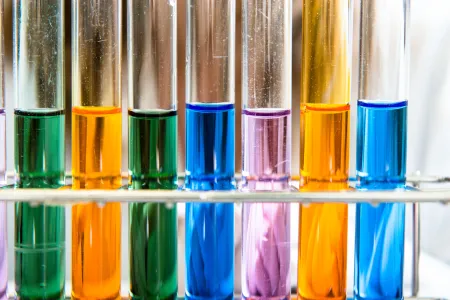
The Bochum research team: Chandan Kumar Das, Lars Schäfer, Subhasri Ghosh, Thomas Happe and Jifu Duan (from left).
Biology
Heat- and Oxygen-Stable Biocatalyst for Hydrogen Production
Newly detected [FeFe]-hydrogenase from a thermophilic bacterium is not degraded by oxygen.
In the absence of air, microorganisms produce hydrogen using an enzyme called [FeFe]-hydrogenase, one of the most efficient hydrogen-producing biocatalysts known and a promising tool for green hydrogen energy. However, these enzymes are rapidly destroyed when exposed to air, which has so far limited their industrial use. Joint efforts led by scientists from the Photobiotechnology group and the Center for Theoretical Chemistry at Ruhr University Bochum, Germany, isolated a new type of oxygen-stable [FeFe]-hydrogenase and revealed its “tricks” for this oxygen-stability. The results are published in “Journal of American Chemical Society” on April 23, 2025.
A selection from thermophilic bacteria
In the pursuit of highly stable [FeFe]-hydrogenase, the team started to search for [FeFe]-hydrogenases from thermophilic bacteria. Employing bioinformatics tools, they found the thermophilic bacterium Thermosediminibacter oceani that thrive around 70˚C and possesses a potentially interesting [FeFe]-hydrogenase.
Understanding the high oxygen stability
After successful production and isolation of this new [FeFe]-hydrogenase, they observed its good thermostability and unprecedented oxygen-stability – it even survives after several days’ exposure to air. “It is so exciting to see this high stability,” says Subhasri Ghosh, the first author of the study. Using hydrogen production measurements, spectroscopy, site-directed mutagenesis, and machine learning-based structure prediction together with molecular dynamics computer simulations, the researchers gained detailed insights into the oxygen protection mechanism. They found that an additional sulfur-containing amino acid located near the catalytic center is crucial for oxygen stability. “Additionally, a cluster of hydrophobic amino acids influences protein dynamics and helps regulate oxygen resistance”, says Professor Lars Schäfer. “We are positive that some of these findings can be applied to other [FeFe]-hydrogenases and possible help in engineering more oxygen-stable [FeFe]-hydrogenases”, concludes Professor Thomas Happe from the Photobiotechnology group Ruhr University Bochum, who led the study.
